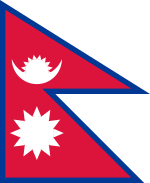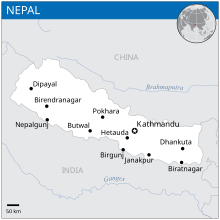Nepalis
|
नेपाली नागरिक Nepalese Citizens
|
|
|---|---|

|
|
| Total population | |
| c. 30 million[1] | |
| Regions with significant populations | |
| 2,926,168[3] | |
| 182,385[4] | |
| 165,000[5] | |
| 80,038[6] | |
| 54,754[7] | |
| 30,000[8] | |
| 17,140[4] | |
| 5,950[9] | |
| 3,937[10] | |
| 3,500[11] | |
| 2,199[12] | |
| Languages | |
| Nepali • Maithili • Bhojpuri • Awadhi • Tharu • Tamang • Newari • Bajjika • Magar • Dotyali • Urdu and 113 others[13] | |
| Religion | |
and others 0.9%[14] |
|
|
a Total population of Nepal, b Nepali-speaking population, c Nepali diaspora |
|
Nepalis (English: Nepalese; Nepali: नेपाली) are citizens of the Federal Democratic Republic of Nepal under the provisions of Nepali nationality law.[15][16] The country is home to people of many different national and ethnic origins. As a result, people of Nepal do not equate their nationality with ethnicity, but with citizenship and allegiance. Although citizens make up the majority of Nepali, non-citizen residents, dual citizen and expatriates may also claim a Nepali identity.
Nepal is a multicultural and multiethnic country. Nepali are multilinguistic group that speak 123 languages as recorded in 2011 Nepal census.[13] Kathmandu Valley, in the middle hill region, constitutes a small fraction of the nation’s area but is the most densely populated, with almost 5 percent of the nation’s population.[2][17]
Etymology
Local legends say that a Hindu sage named “Ne” established himself in the valley of Kathmandu in prehistoric times and that the word “Nepal” came into existence as the place was protected (“pala” in Pali) by the sage “Ne”. It is mentioned in Vedic texts that this region was called Nepal centuries ago. According to the Skanda Purana, a rishi called “Ne” or “Nemuni” used to live in the Himalayas.[18] In the Pashupati Purana, he is mentioned as a saint and a protector.[19] He is said to have practised meditation at the Bagmati and Kesavati rivers[20] and to have taught there.[21]
The name of the country is also identical in origin to the name of the Newar people. The terms “Nepāl”, “Newār”, “Newāl” and “Nepār” are phonetically different forms of the same word, and instances of the various forms appear in texts in different times in history. Nepal is the learned Sanskrit form and Newar is the colloquial Prakrit form.[22] A Sanskrit inscription dated 512 CE found in Tistung, a valley to the west of Kathmandu, contains the phrase “greetings to the Nepals” indicating that the term “Nepal” was used to refer to both the country and the people.[23][24]
Nepali nationality[edit]
The founder of modern Nepal, Badamaharajadhiraja (meaning: Great of the great sovereign kings) Prithvi Narayan Shah[25] is considered a unifying figure and symbol of Nepali National Unity.[26] He is considered a visionary leader and his birthday is celebrated as National Unity Day after years of Maoist hegemony and demolition of monarchial history called as Krambhanga (Paradigm Shift).[27][25]
Nepali caste/ethnic groups
The population ranking of 125 Nepali castes/ethnic groups as per the 2011 Nepal census.[28][note 1]
| Rank | Caste/ethnic groups | Population | Percentage composition |
|---|---|---|---|
| 1 | Chhetri | 4,398,053 | 16.60% |
| 2 | Hill Brahman/Bahun | 3,226,903 | 12.18% |
| 3 | Magar | 1,887,733 | 7.12% |
| 4 | Tharu | 1,737,470 | 6.56% |
| 5 | Tamang | 1,539,830 | 5.81% |
| 6 | Newar | 1,321,933 | 4.99% |
| 7 | Kami | 1,258,554 | 4.75% |
| 8 | Nepali Muslims (taken as a single ethnic group) | 1,164,255 | 4.39% |
| 9 | Yadav | 1,054,458 | 3.98% |
| 10 | Rai | 620,004 | 2.34% |
| 11 | Gurung | 522,641 | 1.97% |
| 12 | Damai/Dholi | 472,862 | 1.78% |
| 13 | Thakuri | 425,623 | 1.61% |
| 14 | Limbu | 387,300 | 1.46% |
| 15 | Sarki | 374,816 | 1.41% |
| 16 | Teli | 369,688 | 1.40% |
| 17 | Chamar/Harijan/Ram | 335,893 | 1.27% |
| 18 | Koiri/Kushwaha | 306,393 | 1.16% |
| 19 | Musahar | 234,490 | 0.89% |
| 20 | Kurmi | 231,129 | 0.87% |
| 21 | Sanyasi/Dasnami | 227,822 | 0.86% |
| 22 | Dhanuk | 219,808 | 0.83% |
| 23 | Dusadh/Pasawan/Pasi | 208,910 | 0.79% |
| 24 | Raute | 618 | 0.00% |
| 25 | Nurang | 278 | 0.00% |
| 26 | Kusunda | 273 | 0.00% |
| – | Others undefined and foreigners | 282,321 | 1.07% |
| – | Total | 26,494,504 | 100.00% |
Gallery[edit]
-
Limbu Male and Female of Nepal









